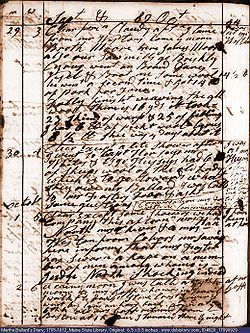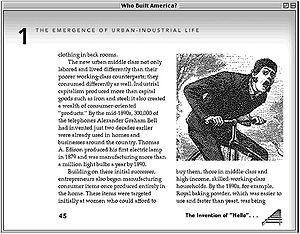Conclusions on Research
From booktorrent
After reviewing an exhaustive number of online museum exhibitions and web-based digital histories, I felt that it was time to provide some criticisms on how well historians have utilized digital media.
If I had to choose one word to best sum up the vast majority of digital histories available via the Web today, it would be clunky. I cannot put enough emphasis on this word (I have tried, as you can clearly see).
A number of these sites, such as the University of Virginia's digital history on the Civil War, or their Race and Place Project have streamlined and aesthetically pleasing main pages, but the ease of navigation falls to pieces once users enter the site itself. Many of these sites have found the need to create an entire page providing an explanation on how to use the site. If the site contains an archive, that archive is typically difficult to find and even more difficult to search. To achieve any sort of historical analysis, the user must sift through pages upon pages of text in much the same way high school students do with textbooks. Tools such as tagging, which prove incredibly useful for web navigation, seem lost on the site designers.
So far, the only things to which I can attribute these difficulties in use are an excess of information, poor site design, and stubborn adherence to the monograph.
Contents |
an excess of information
Most of the histories available online are supplemented with an archive loaded with digitized documents. DoHistory.org's presentation on the diary of Martha Ballard, for instance, contains a digitized copy of the diary, which Martha began on January 1, 1785, and continued to write in every day for 27 years. The archive is huge, and not necessarily loaded with relevant information.
In fact, most of Ballard's entries record only the date and the weather. Entries of any truly historical significance seem somewhat rare and difficult to find. Fortunately for the users of the site, the people at DoHistory have already sorted through any relevant information that can be found in the diary, and can be found through a search using DoHisory's predetermined keywords (e.g. blacks, Indians, river, textiles). My issue with this practice is that by restricting the terms an given individual can use, the people at DoHistory are limiting that individuals ability to draw his or her own historical conclusions. The people at DoHistory profile the story of a rape that Ballard recorded in her diary. Ballard only refers to the rape once in the entire diary, and act itself is presented as an extraneous piece of gossip. Any other conclusions drawn from the text about the subject are drawn by the people at DoHistory.
One of the greatest attributes of digital media is the ease with which it can be made available. What DoHistory demonstrates, and is representative of many digital histories being conducted on the Web today, is that an excess of information can be just as frustrating to rifle through as an absence.
poor site design
Navigating a lot of these online digital histories can be (to put it mildly) frustrating. the Valley of the Shadow website, for instance, divides it's history on the Civil War into three parts according to year. This division seems logical, and would otherwise be a nonissue if it weren't for the site's built-in navigation difficulties. The site has no cohesion. You can trace your way through the maps of the "Eve of War," and end up with the exact same maps found under "The Aftermath." There is a lot of great information in the Valley of the Shadow's website, but the information is nearly worthless to the general viewer without some sort of context or juxtaposition.
One of the strongest arguments for using the Web to conduct and present historical arguments is its ability to present networks of information. Historical analysis is an investigation into different points of view, primary documents, visual representations, and geographical analyses. The great thing about the Web is that it can present all of this information in a context that shows every piece is part of a greater, interconnected culmination. The majority of the digital histories I have come across in my research fail to take advantage of the Web's greatest strength. They present their information in bits and pieces, independent parts that develop and act independently of any historical argument the maker's of the site might be trying to make.
adherence to the monograph
A number of historians are already mourning the death of the "monograph," which is the form that most contemporary historical analysis takes. The monograph is usually defined as a book or article (usually printed) written by one author who is trying to make some sort of historical argument. Given the Internet's strengths and weaknesses, adhering to the monograph to tell the story of history ceases to make sense. And yet, most of the digital histories available on the Web to the general public seem to still be following the monograph as a model for conducting history. These sites are rely heavily on text to form arguments, and many of them end up looking less like digital histories and more like digitized copies of high school textbooks.
What would an effective digital history look like?
After all this discussion on what digital histories are doing wrong, I feel that it is necessary to highlight what digital histories are doing right. There are a few successful digital histories available through the web, and even the sites I complain about above have a few redeeming qualities.
independent, non-academic histories
Some of the most effective digital histories I came across in my research were from non-academic sources with small budgets and limited resources. (This is a shameless plug for a friend, but . . .) Jeff Emtman, a recent graduate from Western Washington University, successfully completed a hitchhiking journey across America in the summer of 2011. Jeff documented the trip in over 2000 photos and many hours of audio recordings. For his online history of the trip, available at http://www.jeffemtman.com, Jeff cut the photos down to 400 photos, and the site includes roughly an hour of audio.
What I like about Jeff's site is its simplicity. Emtman provides access to audio files alongside the photos that correspond to that part of the trip, with little commentary on either medium. The result is a vivid, immersive exploration into Emtman's journey. By limiting his own personal commentaries, Jeff allows his visitors to draw their own conclusions about the people he meets and the places he goes.
a well-worked archive
The Old Bailey Proceedings website is an online digital archive of the proceedings at London's Old Bailey courthouse, which was in operation from 1674-1913. The developers of this site spent a lot of time researching, tagging, and transcribing the minutes of every hearing. They faced challenges such as arbitrary spelling discrepancies, illegible handwriting, and document deterioration. The final product is beautiful, elegant, and (best of all) extremely searchable. You can search names, locations, crimes, dates, nouns, even auxiliary verbs in an easy-to-use keyword search. The following search of the word "candlestick" yielded this result:
Jenkin Cradock, alias Saraden , of the Parish of St. Martins in the Fields , Indicted for Murdering one Christian Eaires . The Evidence against the Prisoner was, That the said Cradock coming by the door where Eaires lived, had some words with her, and so passed away at that time, but came again to the same House about Nine of the Clock at Night, and knocked at the Door, whereupon Eaires coming to him with a Candlestick in her Hand, the Prisoner fell upon her, and threw her down on the ground, and then took the Candlestick out of her Hand, and struck her on the Head with it; by which Wounds she languished, and died; Which being fully proved against the Prisoner the Jury found him guilty of Manslaughter.
The website also provides access to a digitized version of the original document, and map that displays where the crime took place. While the Old Bailey Proceedings website isn't technically a digital history, I think it demonstrates effective archiving strategies that would be imperative to the construction of an effective digital history.
For more on how the Old Bailey Proceedings were constructed, I recommend Digital Histories edited by Ian Anderson. The book is available online through the Evergreen State College.
Conclusion
It seems as if historians have been slow to embrace the digital revolution. The vast majority of academic history continues to be conducted as a printed monograph, and most of the histories available online fail to effectively take advantage of the tools, resources, or abilities that new digital media have to offer. But the fact of the matter is that digital technologies are here to stay. Historians are confronted with digital media more often, and on a increasingly integrated level. I believe that it is imperative that historians are required to take classes in computer programming, web design, and ArcGIS training in order familiarize themselves with their increasingly digital world.



